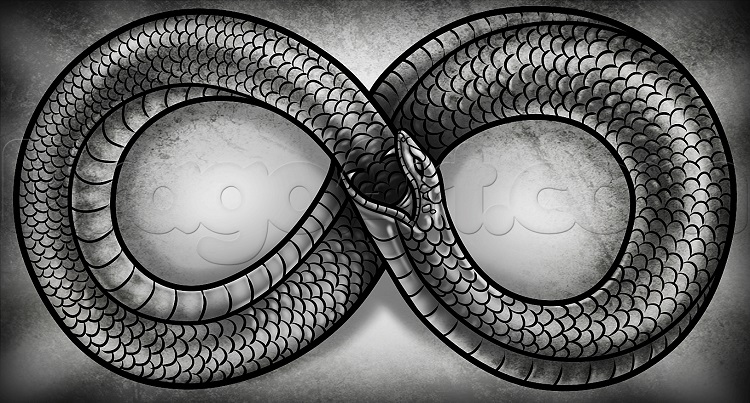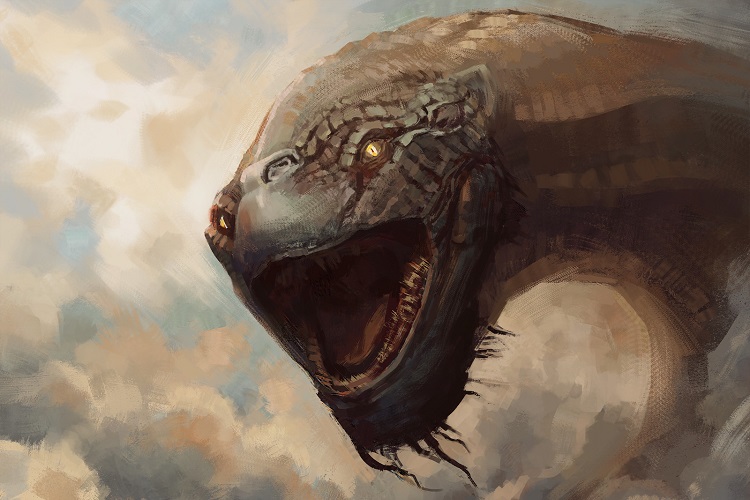What is the Ouroboros?
The ouroboros is an ancient symbol that depicts a serpent eating its own tail. The earliest record of the ouroboros was found in the 1600 BC in ancient Egypt. The symbol was used to document the Egyptians understanding of the sun and was said to represent the travels of the sun disk. It is also thought to represent many other ideas and theories.

The ouroboros is a symbol that can be found in the “Enigmatic Book of the Netherworld.” This book was a funerary text that was found in the tomb of the young King Tut in the 14th century BC.
The book mainly describes Ra and his partnership with Osiris in the underworld. The two serpents that appear in the text hold their tails in their mouths. It is possible that they are somehow also responsible for conveying the cyclic nature of life – with no clear beginning and no end.
The word ‘ouroboros’ itself, however, comes from the Greeks. It is a combination of ‘oura’ which means tail, and ‘bora’ which means food. Combined, they roughly translate to ‘tail eater.’
The Many Uses of the Ouroboros
The Ouroboros has been interpreted in a plethora of ways and has been used by countless cultures to represent the most difficult questions in life. There are also connections between the ouroboros and the universe itself, signifying the importance of the strange image.
Gnosticism and the Ouroboros
Gnosticism is a system of ancient religious ideas that deal with knowledge and the spirit-realm, so it’s no shock that they took up interest in the ouroboros. One of their main beliefs is that salvation can only be found by overcoming ignorance, and the ouroboros is a step in the right direction.
To the believers of Gnosticism, they cyclic nature of the serpent symbolizes the concept of eternity and the very essence of the world itself.
Alchemy and the Ouroboros
Alchemy also has several connections to the ouroboros. One of the most famous is the Chrysopoeia of Cleopatra.
The Chrysopoeia of Cleopatra is a famous alchemical text that was written by an Egyptian philosopher, author, and alchemist. The author’s real name has been lost to history, but it is known that she is not the same person as Cleopatra VII – last ruler of the Ptolemaic Kingdom of Egypt.

Cleopatra the Alchemist was known to have published the Chrysopoeia of Cleopatra and drawn the famous ouroboros that is associated with it. The drawing depicts a serpent eating its tail. The serpent is half white and half black. Additionally, it surrounds text that translates to ‘the all is one.’ This is symbolic for the interconnectedness that is evident in life. This depiction also makes some wonder if it is somehow connected to the yin-yang symbol.
The fact that the ouroboros was used in this text is not coincidental – nor is its relevance fleeting. In alchemy, a Chrysopoeia is a word that indicates that a base metal had undergone ‘transmutation’ into a noble metal like gold. This concept is directly connected to the pursuit of the philosopher’s stone – a substance associated with immortality and rejuvenation. The alchemist’s main pursuit was liberation from the limitations of the human body – a concept that was embodied by the ouroboros.
Sir Thomas Browne
Cleopatra wasn’t the only alchemist to reference the ouroboros in her work. An alchemist and doctor by the name of Sir Thomas Browne also had great interest in the symbol. He wrote a medical treatise entitled, “A Letter to a Friend.” In it, he reflected on the tiring cycle of life and death and the connection of these principles to the ouroboros.
The Theosophical Society
The Theosophical Society was founded in New York City on November 17th, 1875. The group was founded by Helena Petrovna Blavatsky, Colonel Henry Steel Olcott, and William Quan Judge. It was founded to serve as “an unsectarian body of seekers after Truth, who endeavor to promote Brotherhood and strive to serve humanity.”
The society was known to take an alternative approach to spiritualism and studied many mystic and occult practices. Their seal featured the Ankh inside of the Star of David which was below a Swastika. These three symbols were themselves surrounded by an ouroboros. This powerful combination served to symbolize the search for truth and the struggle to understand the interconnectedness of the universe.
The Ouroboros in Mythology
The ouroboros is perhaps most intriguing in its many connections to mythology. It appears that the symbol is used throughout many cultures in ancient history who looked to the serpent figure as a way of explaining the vastness and interconnectedness of the universe. There are many legends that incorporate the ouroboros into their oral traditions – whether directly or figuratively.
Jormungandr
There are many different interpretations of the ouroboros in mythology, but one of the most obvious is the tale of Jormungandr from Norse mythology.

Jormungandr was a serpent – also known as the Midgard Serpent – who grew to be so large and powerful that he was able to encircle the entirety of Midgard and grasp his tail between his teeth. This was thought to hold the world together. In fact – prophecy tells that the world will only end when Jormungandr finally releases his tail, which will start the beginning of Ragnarok.
Norse Mythology
In addition to Jormungandr, Norse mythology also gives us the story of a King who gave his daughter a small lindworm (a serpent monster) as a gift to his daughter. Eventually, it grows so large that it encircles the girl’s home. The King promises his daughter’s hand in marriage to anyone who is able to kill the beast. Eventually, the feat is completed by Ragnar Lodbrok, who goes on to marry the princess.
Later, Ragnar is known to have had a son by another woman. This son is born with the image of a white snake in his eye that is circled around the iris and is biting its own tail. The son was therefore named Sigurd Snake-in-the-Eye.
Shiva
There are often references to the strange symbol in Indian culture as well. These often come in the form of an animal halo that circled around something. This was most often the god Shiva – a fitting choice. Shiva was known to represent the duality in life, much like the ouroboros itself. Shiva is known to mirror the symbolism of the circle he often appears inside. They express death and rebirth, creation and destruction, and eternity in general.
The Milky Way Connection
It is often thought that the ouroboros was invented as a reference to the Milky Way Galaxy and the connection that it has to many of life’s answers that we seek. There are many references in mythology to ‘the serpent of light’ that supposedly lived in the heavens. This serpent resembles the ouroboros and the location is an obvious reference to the galaxy. There are those who wonder if the connection of this symbol to space means that our ancestors were able to answer questions that still hold mystery for many today.
Plato’s Description of the First Being
In his work, Timaeus, Plato refers to the ouroboros as the first living creature in existence. As the first, it was the most perfect because of its self-sufficiency. The ouroboros had no eyes because outside itself there was nothing to be seen. It had no ears because there was nothing outside itself to listen to. This creature was a self-eating and circular being. Despite of its self-eating nature, however, it had no organs that would allow it to digest for there was nothing that could come into its system that existed outside of itself. It also lacked the ability to breathe for similar reasons.
The only one of the senses that this creature was given was the ability to move and writhe in it’s circular nature that represented the essence of its being. This story is often referred to by those who reflect on the mysteries of the ouroboros in modern day.
The Ouroboros in Science
The structure of the compound benzene was supposedly discovered by a chemist named August Kekule when he was earnestly studying atom structure in an attempt to find an answer. Frustrated, he eventually took a nap by his fireplace. While dreaming, he explored the image of atoms working together and eventually appearing to move and writhe like snakes. Suddenly, one of the snakes grabbed its tail in its mouth – prompting Kekule to awaken. This vision of the ouroboros in atom form inspired Kekule to continue working out his equations until he was able to prove the form of the benzene.










